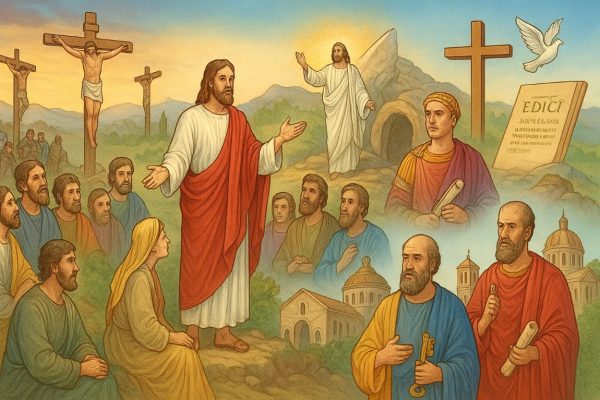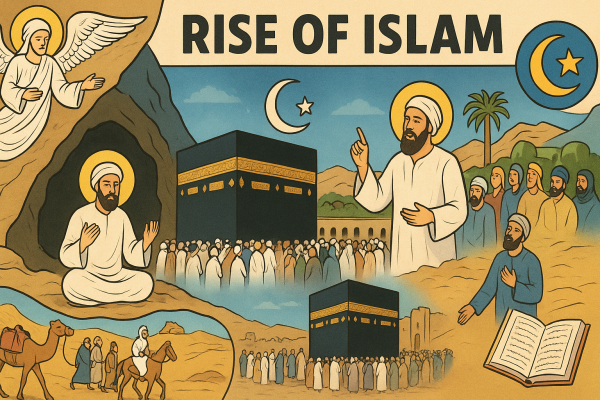1st PUC History Question and Answer – Rise and Spread of Christianity and Islam
Looking for 1st PUC History textbook answers? You can download Chapter 5: Rise and Spread of Christianity and Islam Questions and Answers PDF, Notes, and Summary here. 1st PUC History solutions follow the Karnataka State Board Syllabus, making it easier for students to revise and score higher in exams.
Karnataka 1st PUC History Textbook Answers—Reflections Chapter 5
Rise and Spread of Christianity and Islam Questions and Answers, Notes, and Summary
1st PUC History Chapter 5
Rise and Spread of Christianity and Islam
Scroll Down to Download Rise and Spread of Christianity and Islam PDF
I. Answer in one word Or one sentence.
Question 1.
Which is the biggest Religion in the World?
Answer:
Christianity.
Question 2.
Who was the founder of Christianity?
Answer:
Jesus Christ.
Question 3.
Which is the emblem of Christianity?
Answer:
Cross.
Question 4.
Which was the religious centre of Jews?
Answer:
Jerusalem.
Question 5.
Which God was worshipped by Jews?
Answer:
Jehovah.
Question 6.
Which was the religious text of Jews?
Answer:
Old Testament / Hebrew Bible.
Question 7.
Who was the religious Prophet of Jews?
Answer:
Moses.
Question 8.
When was Jesus Christ born?
Answer:
25th December, 4 B.C.E.
Question 9.
Where was Jesus born?
Answer:
Bethlehem in Judea.
Question 10.
What do you mean by Christ?
Answer:
Anointed One.
Question 11.
On which hill was Jesus crucified?
Answer:
Mount Calvary (Golgotha).
Question 12.
What is Easter Sunday?
Answer:
The day celebrating Resurrection of Jesus.
Question 13.
Which part of the Bible contains the teachings of Jesus?
Answer:
New Testament (Gospels).
Question 14.
What was Milan Edict?
Answer:
Law granting legal recognition to Christianity (313 C.E).
Question 15.
Who was the first Roman emperor to accept Christianity?
Answer:
Constantine.
Question 16.
Who was the Roman emperor to declare Christianity as National religion?
Answer:
Theodosius.
II. Answer in two words Or two sentences.
Question 1.
Who were the parents of Jesus?
Answer:
Joseph and Virgin Mary.
Question 2.
Which are the two Parts of Bible?
Answer:
Old Testament and New Testament.
Question 3.
When was Jesus crucified? Who was the Roman Governor at that time?
Answer:
30 C.E; Pontius Pilate.
Question 4.
What was Resurrection of Jesus?
Answer:
Rising of Jesus from death on the third day after crucifixion.
Question 5.
Name the two important disciples of Jesus.
Answer:
St. Peter and St. Paul.
Question 6.
Name the two Roman Emperors who tortured Christians?
Answer:
Nero and Diocletian.
Question 7.
Who issued Milan Edict? When?
Answer:
Constantine, in 313 C.E.
Question 8.
Who were the two Roman emperors who gave royal patronage to Christianity?
Answer:
Constantine and Theodosius.
Question 9.
Which are the important Festivals of Christians?
Answer:
Christmas, Good Friday, and Easter.
Question 10.
Which are the two sects of Christianity?
Answer:
Roman Catholics and Protestants.
III. Answer in 15to 20 sentences.
Question 1.
Write about the life history of Jesus.
Answer:
Jesus Christ, the founder of Christianity, was born in 4 B.C.E. at Bethlehem in Judea. His parents were Joseph, a carpenter, and Virgin Mary. He spent his early life in Nazareth, and hence was also called “Jesus of Nazareth.” At the age of 12, he surprised people in a Jewish synagogue by explaining the religious texts. Jesus led a very simple life, helping the poor, sick, and needy. He was influenced by John the Baptist and was baptized by him at the age of 30. After baptism, he began his life as a wandering preacher.
He chose 12 disciples to spread his message. Jesus preached about the fatherhood of God and the brotherhood of men. His teachings were often given through parables. His popularity among the poor and oppressed worried the orthodox Jews and Roman rulers. He was condemned by Pontius Pilate and crucified on Mount Calvary (Golgotha) in 30 C.E. According to belief, he resurrected on the third day after crucifixion, which is celebrated as Easter. His life emphasized love, compassion, sacrifice, and forgiveness. Because of his virtues, Jesus is remembered as “Christ,” meaning “the Anointed One.” His life story inspired millions and became the foundation of Christianity.
Question 2.
Explain the teachings of Jesus Christ.
Answer:
The teachings of Jesus Christ are mainly found in the New Testament of the Bible. He preached the existence of one God, who is merciful and omnipotent. Jesus emphasized the fatherhood of God and the brotherhood of men. He taught people to love their neighbors as well as their enemies. Forgiveness and compassion were central to his message. He stressed humility, purity of heart, and sincerity as gateways to heaven. Jesus criticized greed and worldly riches, saying those with mercy and service-mindedness will reach the kingdom of heaven. His famous “Sermon on the Mount” highlights blessings to the poor, the humble, and the pure in spirit.
He believed in simple ceremonies instead of rigid rituals. According to him, “Service to people is service to God.” Jesus also instructed people not to steal, not to commit adultery, and to respect elders. He insisted that justice, mercy, sacrifice, and humility were greater than blind customs. His spiritual message brought hope to the poor, oppressed, and sinners. Jesus also opposed social discrimination and taught equality among all. His teachings continue to inspire humanity with love, peace, and kindness.
Question 3.
Which were the important causes for the spread of Christianity?
Answer:
The spread of Christianity was due to several important causes. First, the simplicity of Jesus and his teachings attracted the poor, sinners, and oppressed people. His spiritual power and compassion inspired many followers. Second, the principles of fraternity, forgiveness, and hope in the kingdom of heaven appealed to the common people, especially slaves. Third, the role of apostles like St. Peter and St. Paul was crucial. St. Peter founded the first church at Rome, while St. Paul spread Christianity to Greece, Rome, and other regions, and is known as the “Second Jesus.” Fourth, the martyrdom of early Christians inspired others to embrace the faith.
Despite persecution by emperors like Nero and Diocletian, Christianity survived. Fifth, the role of the Church was very significant, as people saw it as the gateway to heaven, and the Pope as God’s representative. Sixth, the conversion of Emperor Constantine was a turning point; he issued the Edict of Milan in 313 C.E., making Christianity a legal religion. Later, Theodosius declared it the state religion of Rome. Finally, the missionary work in different countries, including India, helped Christianity to spread widely. Thus, by the 5th century C.E., Europe was largely Christianized.
5.2. ISLAM
I. Answer in one word Or one sentence
Question 1.
Who was the founder of Islam?
Answer:
Prophet Mohammed.
Question 2.
Which is the holy place of Muslims?
Answer:
Mecca.
Question 3.
Who was the uncle of Prophet?
Answer:
Abu Talib.
Question 4.
Who was the wife of Prophet?
Answer:
Khadija.
Question 5.
On which hilly cave did Mohammed meditate?
Answer:
Cave of Hira.
Question 6.
Who was the messenger who preached the gospels to Prophet?
Answer:
Angel Gabriel (Jibreel).
Question 7.
Which was the stone worshipped by Muslims at Mecca?
Answer:
Black Stone (Hajr-e-Aswad).
Question 8.
When did Prophet die?
Answer:
632 C.E.
Question 9.
Which is the holy book of Islam?
Answer:
Quran.
Question 10.
What is Kalima?
Answer:
Declaration of faith in one God and Mohammed as His Prophet.
Question 11.
What is Namaz?
Answer:
Daily prayer of Muslims.
Question 12.
What is Zaqqat?
Answer:
Religious tax for the poor.
Question 13.
What is Roza?
Answer:
Fasting during the month of Ramadan.
Question 14.
What is Hajj?
Answer:
Pilgrimage to Mecca.
II. Answer in two words Or two sentences
Question 1.
Which is the symbol of Islam and name the religious centre of Muslims.
Answer:
Crescent and Star; Mecca.
Question 2.
When and where was the prophet born?
Answer:
570 C.E.; Mecca.
Question 3.
Who were the parents of Mohammad?
Answer:
Father – Abdullah; Mother – Amina.
Question 4.
Name the daughter and son-in-law of Mohammad.
Answer:
Daughter – Fatima; Son-in-law – Ali.
Question 5.
What is the meaning of Islam?
Answer:
Submission to God; Peace.
Question 6.
Which are the two sects of Islam?
Answer:
Shia and Sunni.
III. Answer in 15 to 20 sentences.
Question 1.
Write about the life history of Mohammad.
Answer:
Prophet Mohammad, the founder of Islam, was born in 570 C.E. at Mecca in Arabia. His father Abdullah died before his birth, and his mother Amina passed away when he was six years old. He grew up under the care of his grandfather Abdul Muttalib and later his uncle Abu Talib. Mohammad was known for his honesty and was called “Al-Amin” (the trustworthy). At the age of 25, he married Khadija, a wealthy widow, who supported him in his mission. He often meditated in the cave of Hira near Mecca. At the age of 40, he received his first revelation from Angel Gabriel (Jibreel).
These revelations continued throughout his life and were later compiled into the Holy Quran. He began to preach monotheism, teaching that there is only one God – Allah. His teachings faced opposition from the Quraysh leaders of Mecca. Due to persecution, he and his followers migrated to Medina in 622 C.E., known as the Hijra, which marks the beginning of the Islamic calendar. In Medina, he established a strong religious and political community. Later, he returned to Mecca, cleansed the Kaaba of idols, and made it the holy centre of Islam. He continued spreading Islam across Arabia until his death in 632 C.E. at Medina. His life remains a source of inspiration for millions of Muslims worldwide.
Question 2.
Explain the teachings of Prophet Mohammad.
Answer:
The teachings of Prophet Mohammad are based on the belief in one God, Allah. He emphasized that Allah is the creator, sustainer, and ruler of the universe. Mohammad taught that all humans are equal before God, regardless of race, wealth, or status. He opposed idol worship and promoted monotheism. He stressed the importance of truthfulness, honesty, and justice in personal and social life. He preached compassion, kindness, and charity towards the poor and needy. One of his key teachings was the Five Pillars of Islam: Kalima (faith), Namaz (prayer), Zakat (charity), Roza (fasting during Ramadan), and Hajj (pilgrimage to Mecca).
He insisted that prayer should be offered five times a day. He encouraged fasting during the month of Ramadan as a way to develop self-control and piety. Charity (Zakat) was made compulsory to reduce poverty and inequality. He also made pilgrimage to Mecca a sacred duty for Muslims. He opposed social evils like female infanticide, injustice, and exploitation of the weak. Mohammad preached universal brotherhood and equality of all believers. His teachings formed the foundation of Islam, which later spread rapidly across Asia, Africa, and Europe. Even today, Muslims follow his teachings as guidance for righteous living.


